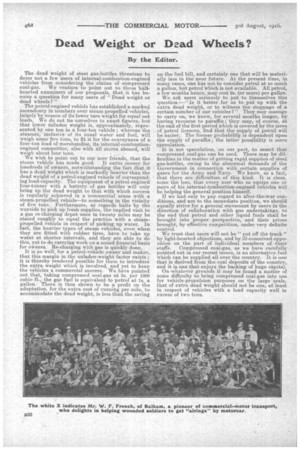Dead Weight or Dead Wheels?
Page 8

If you've noticed an error in this article please click here to report it so we can fix it.
By the Editor.
The dead weight of steel gas-bottles threatens to deter not a few users of internal-combustion-engined vehicles from considering the claims of compressed coal-gas. We venture to point out to these 'halthearted examiners of our proposals, that it has become a question for many users of "Dead weight or dead wheels?"
The petrol-engined vehicle has established a. market( ascendency in numbers over steam-propelled largely by reason of its lower tare weight for equal net loads. We do not tie ourselves to exact figures, but that lower unladen weight is, approximately, represented by one ton in a four-ton vehicle ; whereas the steamer, inclusive of its usual water and fuel, will weigh some five tons, to fit it for the conveyance of a four-ton load of merchandise, its internal-combustionengined competitor, also with all stores aboard, will weigh about four tons.
We wish to point out to our user friends, that the steam vehicle has made good. It earns money for hundreds of owners, notwithstanding the fact that it has a dead weight which is markedly heavier than the dead weight of a petrol-engined vehicle of corresponding load-capacity. The equipment of a petrol-engined four-tanner with a battery of gas bottles will only bring up the dead weight to that with which success is regularly achieved in a commercial sense with a steam-propelled vehicle—to something in the vicinity of five tons. Furthermore, as regards halts by the wayside to pick tin fresh supplies, the implied visit to a gas re-charging depot once in twenty miles may be stated roughly to equal the practice with a steampropelled vehicle in respect of picking up water. In fact, the heavier types of steam vehicles, even when they are fitted with rubber tires, have to take up water at shorter intervals, and they are able to do this, yet to do carrying work on a sound financial basis for owners. Ite-charging with as is quickly done. It is as well, for a petrol-vehicle owner and maker, that this margin in the unladen-weight factor exists ; it is thereby rendered possible for them to introduce the extra weight which is involved, and yet to keep the vehicles a commercial success. We have pointed out that,. taking compressed coal-gas at 3s. per 1000 cubic ft., the gas fuel is equivalent to petrol at is. a gallon. There is thus shown to be a profit on the adaptation, for the extra cost of running per mile, ta accommodate the dead weight, is less than the saving on the fuel bill, and certainly one that will be materially less in the near future. At the present time, in many cases one has not to consider petrol at so much a gallon, Init petrol which is not available. All petrol, a few months hence, may cost 2s. (or more) per gallon.
We ask users seriously to put to themselves this question :—" Is it better for us to put up with the extra dead weight, or to witness the stoppage of a certain number of our vehicles ? " They may manage to carry on, we know, for several months longer, by having recourse to paraffin .. they may, of course, at the end of the first period which is covered by the issue . of petrol licences, .find that the supply of petrol will be easier. The former probability is dependent upon. the supply of paraffin ; the latter possibility is mere speculation. It is not speculation, on our part, to assert that compressed coal-gas can be used. There may be difficulties in the matter of getting rapid supplies of steel gas-bottles, owing to the abnormal demands of the Government in connection with certain supplies of gases for the Army and Navy. We know, as a fact, that there are difficulties of this kind. It is clear, none the less, that every user who so equips one or more of his internal-cotribustion-engined vehicles will be helping the general position himself. If we had only to pay regard to after-the-war conditions, and not to the immediate position, we should equally strive for a general -movement by users in the direction of collaboration with gas undertakings, to the end that petrol and other liquid fuels shall be brought into proper perspective, and their prices brought, by effective competition, under very definite control.
We trust that users will not be "put off the track " by light-hearted objections, and by ill-conceived opposition on the part of individual members of• their staffs. Compressed coal-gas, as we have carefully pointed out in our recent issues, is an alternative fuel which can be supplied all over the country. It is one that is derived from the coal deposits of the country, and it is one that enjoys the backing of huge capital. On whatever grounds it may be found a matter of some difficulty to bring compressed coal-gas into use for vehicle-propulsion purposes on the large scale, that of extra dead weight should not be one, at least in respect of vehicles with a load capacity well in excess of two tons.




















